Research on Design and Optimization of Large Metal Bipolar Plate Sealing for Proton Exchange Membrane Fuel Cells
Abstract
:1. Introduction
2. Sealing Principle and Sealing Structure
2.1. Principle of Elastomer Seal for Metal Plates
2.2. Sealing Structure Design
3. Experimental and Simulation Theory
3.1. Finite Element Model and Sealing Requirements
- The rubber material has a general elastic modulus E and Poisson’s ratio μ.
- Although rubber materials have Poisson’s ratio, their actual Poisson’s ratio is 0.5, which is an incompressible material. In this paper, it is assumed that its Poisson’s ratio is 0.49.
- The creep properties of the sealing gasket are the same in all directions. The volume of the sealing gasket is not affected by material creep.
- The stiffness of the groove made of steel components is several times that of rubber and can be considered as the constrained boundary when the gasket deforms.
3.2. Sealing Performance Experiment
3.3. The Path-Flow Procedures of the Research
4. Results and Discussion
4.1. Simulation Analysis of Different Sealing Structures
4.2. Comparison of Sealing Materials with Different Hardness
4.3. Comparison of Different Coefficients of Friction
4.4. Comparison of Different Compression Ratios
4.5. Experimental Analysis and Verification of Sealing Structure
5. Conclusions
- A double-peak sealing gasket structure with two extended wings had a better sealing effect when it was in contact with the membrane electrode frame. In addition, a new type of offset sealing structure optimization was able to effectively improve the sealing effect at the gas–liquid inlet and outlet of the metal bipolar plate.
- The maximum contact pressure values on the upper and lower contact surfaces were 1.89 MPa and 0.96 MPa, respectively, for EPDM rubber with a hardness of 45 Shore A, and 3.69 MPa and 1.88 MPa, respectively, for EPDM rubber with a hardness of 60 Shore A. And the contact pressure between the metal rubber seal and the plate increased exponentially with the hardness of the rubber, causing significant deformation of the metal bipolar plate.
- The larger the friction coefficient of the metal rubber, the greater the contact pressure at the sealing contact surface, but the change in pressure is relatively smooth. Considering the condition of water lubrication, a friction coefficient of 0.05 could be recommended for adoption.
- The maximum contact pressure on the upper contact surfaces increased from 1.89 MPa to 2.58 MPa, while the compression ratio increased from 35% to 40%. The contact pressure between the metal rubber seal and the plate was approximately exponential with the compression ratio of the rubber, and the contact pressure gradually increased with the increase in the compression ratio. Therefore, it is necessary to limit the compression ratio of the sealing gasket according to the requirements of the MEA in practical engineering.
- The double-peak sealing gasket with extended wings was fabricated and assembled into a single fuel cell for testing. The results showed that the simulation and experimental sealing performance of the sealing gasket under different compression ratios remained similar. In order to ensure the sealing effect of the fuel cell metal stack, the sealing structure parameters can be referred to as follows: the roughness of the bipolar plate should be controlled within 0.08 mm; the hardness of the EPDM rubber should be 45 Shore A; the friction coefficient should be 0.05; and the initial compression ratio should be 35%. The results of this study can provide a reference for the sealing structure design of large metal bipolar plates in PEMFCs.
Author Contributions
Funding
Institutional Review Board Statement
Informed Consent Statement
Data Availability Statement
Conflicts of Interest
References
- Daud, W.; Rosli, R.; Majlan, E.; Hamid, S.; Mohamed, R.; Husaini, T. PEM fuel cell system control: A review. Renew. Energy 2017, 113, 620–638. [Google Scholar] [CrossRef]
- Corigliano, O.; Pagnotta, L.; Fragiacomo, P. On the Technology of Solid Oxide Fuel Cell (SOFC) Energy Systems for Stationary Power Generation: A Review. Sustainability 2022, 14, 15276. [Google Scholar] [CrossRef]
- Fragiacomo, P.; Genovese, M.; Piraino, F.; Corigliano, O.; De Lorenzo, G. Hydrogen-Fuel Cell Hybrid Powertrain: Conceptual Layouts and Current Applications. Machines 2022, 10, 1121. [Google Scholar] [CrossRef]
- Fragiacomo, P.; Piraino, F.; Genovese, M.; Corigliano, O.; De Lorenzo, G. Strategic Overview on Fuel Cell-Based Systems for Mobility and Electro-lytic Cells for Hydrogen Production. Procedia Comput Sci. 2022, 200, 1254–1263. [Google Scholar] [CrossRef]
- Miyake, J.; Ogawa, Y.; Tanaka, T.; Ahn, J.; Oka, K.; Oyaizu, K.; Miyatake, K. Rechargeable proton exchange membrane fuel cell containing an intrinsic hydro-gen storage polymer. Commun. Chem. 2020, 3, 138. [Google Scholar] [CrossRef]
- Lim, B.; Majlan, E.; Daud, W.; Rosli, M.; Husaini, T. Three-dimensional study of stack on the performance of the proton exchange membrane fuel cell. Energy 2019, 169, 338–343. [Google Scholar] [CrossRef]
- Shi, D.; Cai, L.; Zhang, C.; Chen, D.; Pan, Z.; Kang, Z.; Zhang, J. Fabrication methods, structure design and durability analysis of advanced sealing ma-terials in proton exchange membrane fuel cells. Chem. Eng. J. 2022, 454, 139995. [Google Scholar] [CrossRef]
- Pehlivan-Davis, S.; Clarke, J.; Armour, S. Comparison of accelerated aging of silicone rubber gasket material with aging in a fuel cell environment. J. Appl. Polym. Sci. 2013, 129, 1446–1454. [Google Scholar] [CrossRef]
- Bhargava, S.; O’Leary, K.A.; Jackson, T.C.; Lakshmanan, B. Durability testing of silicone materials for proton exchange membrane fuel cell use. Rubber Chem. Technol. 2013, 86, 28–37. [Google Scholar] [CrossRef]
- De Bruijn, F.A.; Dam, V.A.T.; Janssen, G.J.M. Review: Durability and Degradation Issues of PEM Fuel Cell Components. Fuel Cells 2008, 8, 3–22. [Google Scholar] [CrossRef]
- Liang, P.; Qiu, D.; Peng, L.; Yi, P.; Lai, X.; Ni, J. Structure failure of the sealing in the assembly process for proton exchange membrane fuel cells. Int. J. Hydrog. Energy 2017, 42, 10217–10227. [Google Scholar] [CrossRef]
- Wang, Z.; Tan, J.; Wang, Y.; Liu, Z.; Feng, Q. Chemical and mechanical degradation of silicone rubber under two compression loads in simulated proton-exchange membrane fuel-cell environments. J. Appl. Polym. Sci. 2019, 136, 47855. [Google Scholar] [CrossRef]
- Tan, J.; Chao, Y.; Yang, M.; Lee, W.-K.; Van Zee, J. Chemical and mechanical stability of a Silicone gasket material exposed to PEM fuel cell environment. Int. J. Hydrog. Energy 2011, 36, 1846–1852. [Google Scholar] [CrossRef]
- Tan, J.; Chao, Y.; Van Zee, J.; Li, X.; Wang, X.; Yang, M. Assessment of mechanical properties of fluoroelastomer and EPDM in a simulated PEM fuel cell environment by microindentation test. Mater. Sci. Eng. A 2008, 496, 464–470. [Google Scholar] [CrossRef]
- Tan, J.; Chao, Y.; Van Zee, J.; Lee, W. Degradation of elastomeric gasket materials in PEM fuel cells. Mater. Sci. Eng. A 2007, 445–446, 669–675. [Google Scholar] [CrossRef]
- Schulze, M.; Knöri, T.; Schneider, A.; Gülzow, E. Degradation of sealings for PEFC test cells during fuel cell operation. J. Power Sources 2004, 127, 222–229. [Google Scholar] [CrossRef]
- Lin, C.W.; Chien, C.H.; Tan, J.; Chao, Y.J.; Van Zee, J.W. Chemical degradation of five elastomeric seal materials in a simulated and an accelerated PEM fuel cell environment. J. Power Sources 2011, 196, 1955–1966. [Google Scholar] [CrossRef]
- Mitra, S.; Ghanbari-Siahkali, A.; Kingshott, P.; Rehmeier, H.K.; Abildgaard, H.; Almdal, K. Chemical degradation of crosslinked ethylene-propylene-diene rub-ber in an acidic environment. Part I. Effect on accelerated sulphur crosslinks. Polym. Degrad. Stab. 2006, 91, 69–80. [Google Scholar] [CrossRef]
- Mitra, S.; Ghanbari-Siahkali, A.; Kingshott, P.; Almdal, K.; Rehmeier, H.K.; Christensen, A.G. Chemical degradation of fluoroelastomer in an alkaline environment. Polym. Degrad. Stab. 2004, 83, 195–206. [Google Scholar] [CrossRef]
- Feng, J.; Zhang, Q.; Tu, Z.; Tu, W.; Wan, Z.; Pan, M.; Zhang, H. Degradation of silicone rubbers with different hardness in various aqueous solutions. Polym. Degrad. Stab. 2014, 109, 122–128. [Google Scholar] [CrossRef]
- Cui, T.; Chao, Y.; Van Zee, J. Sealing force prediction of elastomeric seal material for PEM fuel cell under temperature cycling. Int. J. Hydrog. Energy 2014, 39, 1430–1438. [Google Scholar] [CrossRef]
- Cui, T.; Chao, Y.; Van Zee, J. Thermal stress development of liquid silicone rubber seal under temperature cycling. Polym. Test. 2013, 32, 1202–1208. [Google Scholar] [CrossRef]
- Chien, C.-H.; Lin, C.-W.; Chao, Y.-J.; Tong, C.; Van Zee, J. Compression of Seals in PEM Fuel Cells. Exp. Mech. Emerg. Energy Sys. Mater. 2011, 5, 183–192. [Google Scholar] [CrossRef]
- Zhang, J.; Hu, Y. Sealing performance and mechanical behavior of PEMFCs sealing system based on thermodynamic coupling. Int. J. Hydrog. Energy 2020, 45, 23480–23489. [Google Scholar] [CrossRef]
- Achenbach, M. Service life of seals—Numerical simulation in sealing technology enhances prognoses. Comput. Mater. Sci. 2000, 19, 213–222. [Google Scholar] [CrossRef]
- Achenbach, M. Development of a robust fuel circuitsealing system: Achieving a solution. Seal Technol. 2007, 2007, 7–10. [Google Scholar] [CrossRef]
- Su, Z.Y.; Liu, C.T.; Chang, H.P.; Li, C.H.; Huang, K.J.; Sui, P.C. A numerical investigation of the effects of compression force on PEM fuel cell performance. J. Power Sources 2008, 183, 182–192. [Google Scholar] [CrossRef]
- Xing, S.; Zhao, C.; Liu, W.; Zou, J.; Chen, M.; Wang, H. Effects of bolt torque and gasket geometric parameters on open-cathode polymer electrolyte fuel cells. Appl. Energy 2021, 303, 117632. [Google Scholar] [CrossRef]
- Huang, X.; Liu, S.; Yu, X.; Liu, Y.; Zhang, Y.; Xu, G. A mechanism leakage model of metal-bipolar-plate PEMFC seal structures with stress relaxation effects. Int. J. Hydrog. Energy 2022, 47, 2594–2607. [Google Scholar] [CrossRef]
- Qiu, D.; Liang, P.; Peng, L.; Yi, P.; Lai, X.; Ni, J. Material behavior of rubber sealing for proton exchange membrane fuel cells. Int. J. Hydrog. Energy 2020, 45, 5465–5473. [Google Scholar] [CrossRef]
- Cleghorn, S.; Mayfield, D.; Moore, D.; Moore, J.; Rusch, G.; Sherman, T.; Sisofo, N.; Beuscher, U. A polymer electrolyte fuel cell life test: 3 years of continuous operation. J. Power Sources 2006, 158, 446–454. [Google Scholar] [CrossRef]
- Tan, J.; Chao, Y.J.; Li, X.; Van Zee, J.W. Degradation of silicone rubber under compression in a simulated PEM fuel cell environment. J. Power Sources 2007, 172, 782–789. [Google Scholar] [CrossRef]
- Basuli, U.; Jose, J.; Lee, R.H.; Yoo, Y.H.; Jeong, K.-U.; Ahn, J.-H.; Nah, C. Properties and Degradation of the Gasket Component of a Proton Exchange Membrane Fuel Cell—A Review. J. Nanosci. Nanotechnol. 2012, 12, 7641–7657. [Google Scholar] [CrossRef]
- Tan, J.; Chao, Y.; Wang, H.; Gong, J.; Van Zee, J. Chemical and mechanical stability of EPDM in a PEM fuel cell environment. Polym. Degrad. Stab. 2009, 94, 2072–2078. [Google Scholar] [CrossRef]
- Cui, T.; Chao, Y.; Van Zee, J. Stress relaxation behavior of EPDM seals in polymer electrolyte membrane fuel cell environment. Int. J. Hydrog. Energy 2012, 37, 13478–13483. [Google Scholar] [CrossRef]
- Xu, Q.; Zhao, J.; Chen, Y.; Liu, S.; Wang, Z. Effects of gas permeation on the sealing performance of PEMFC stacks. Int. J. Hydrog. Energy 2021, 46, 36424–36435. [Google Scholar] [CrossRef]
- Palasantzas, G. Influence of self-affine roughness on the adhesive friction coefficient of a rubber body sliding on a solid substrate. Surf. Sci. 2004, 565, 191–196. [Google Scholar] [CrossRef]
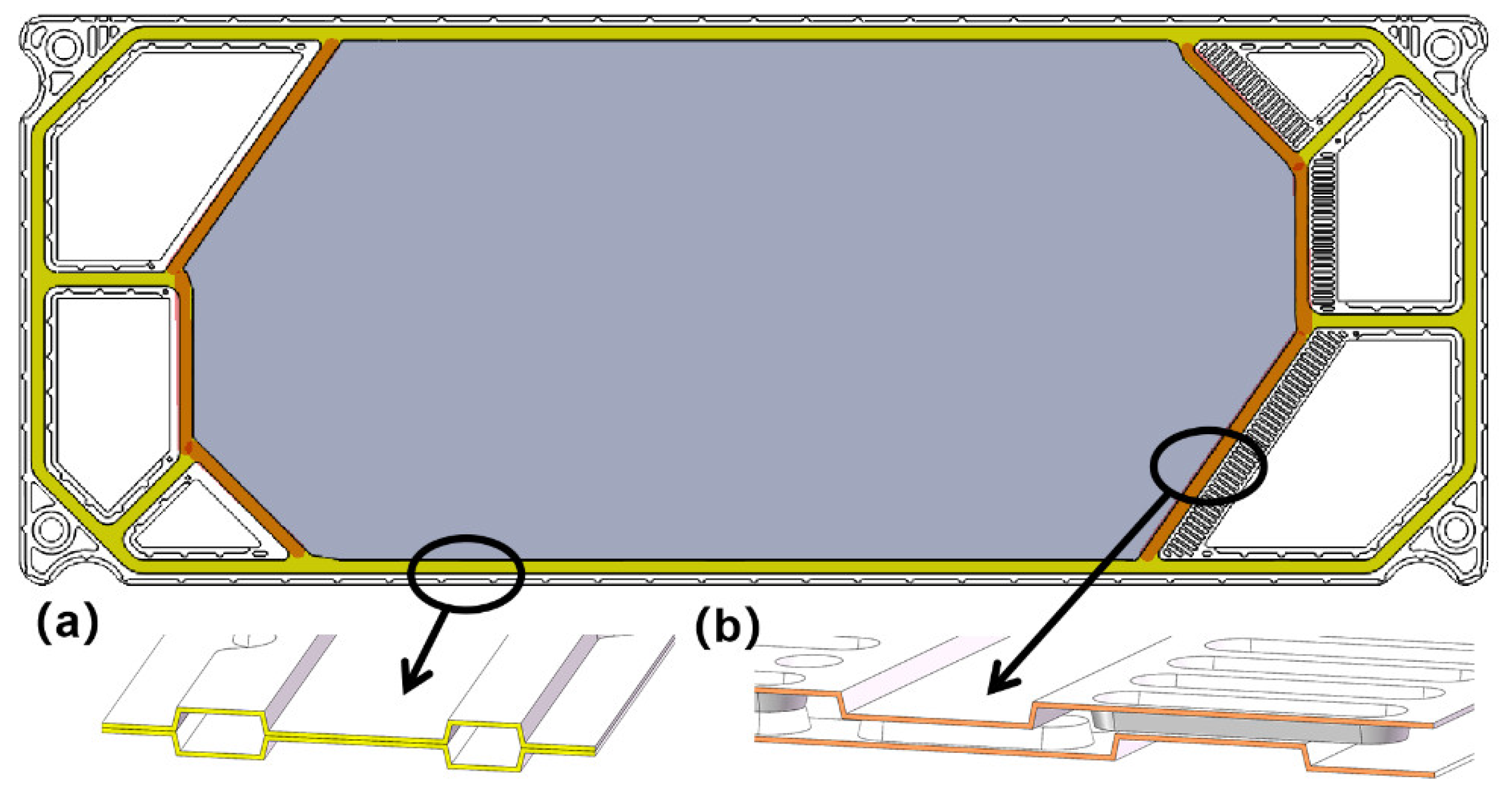
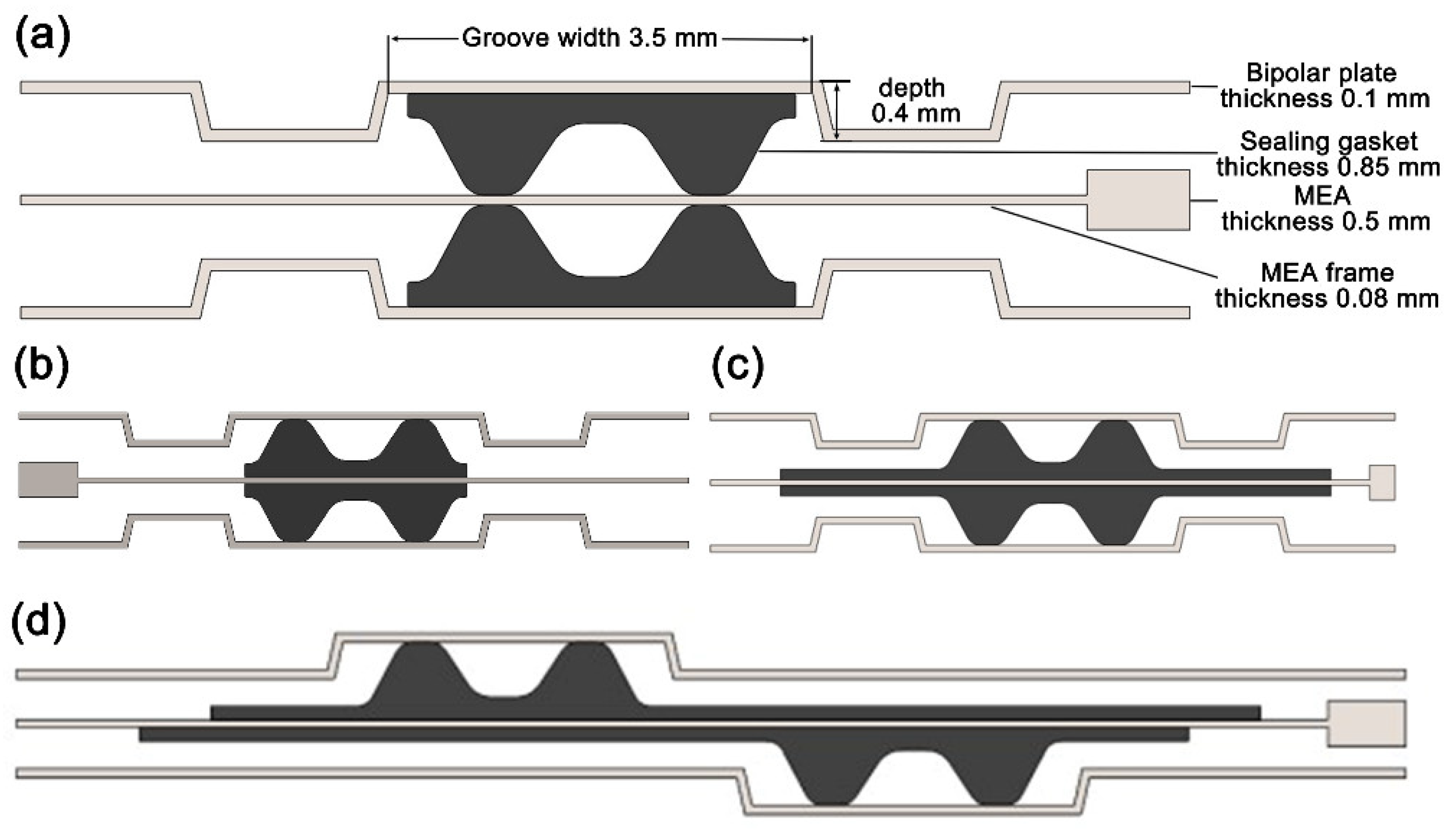


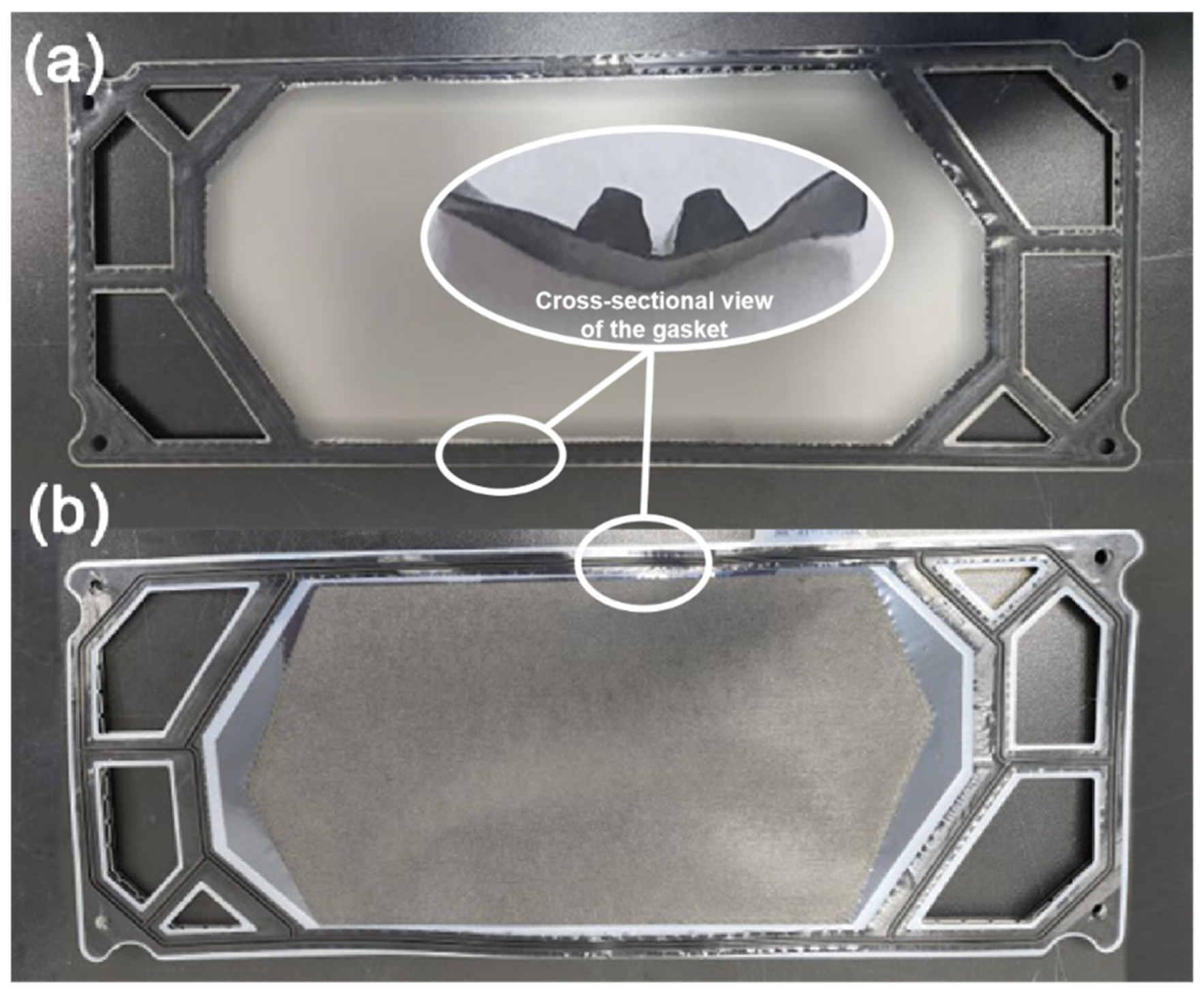
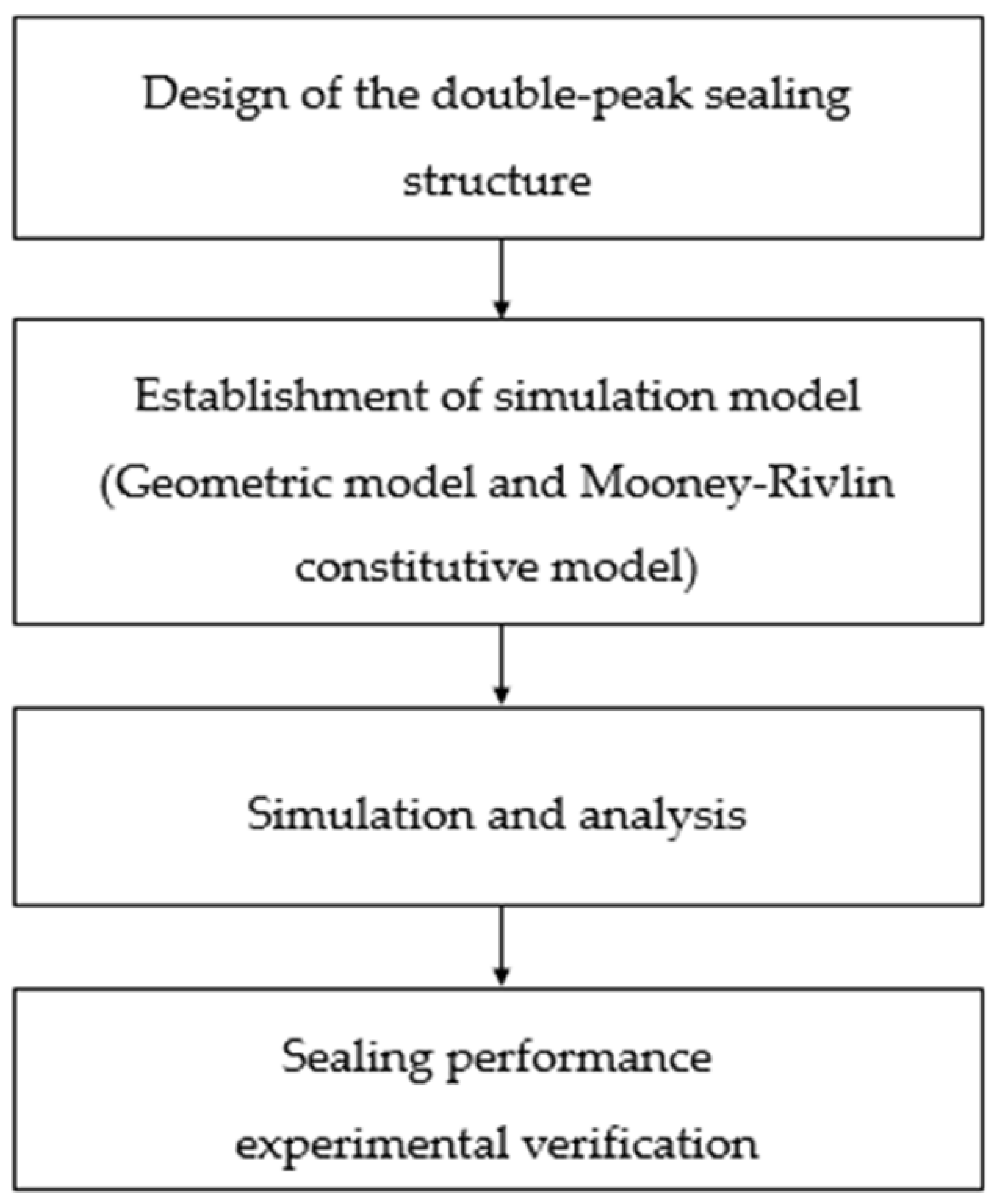
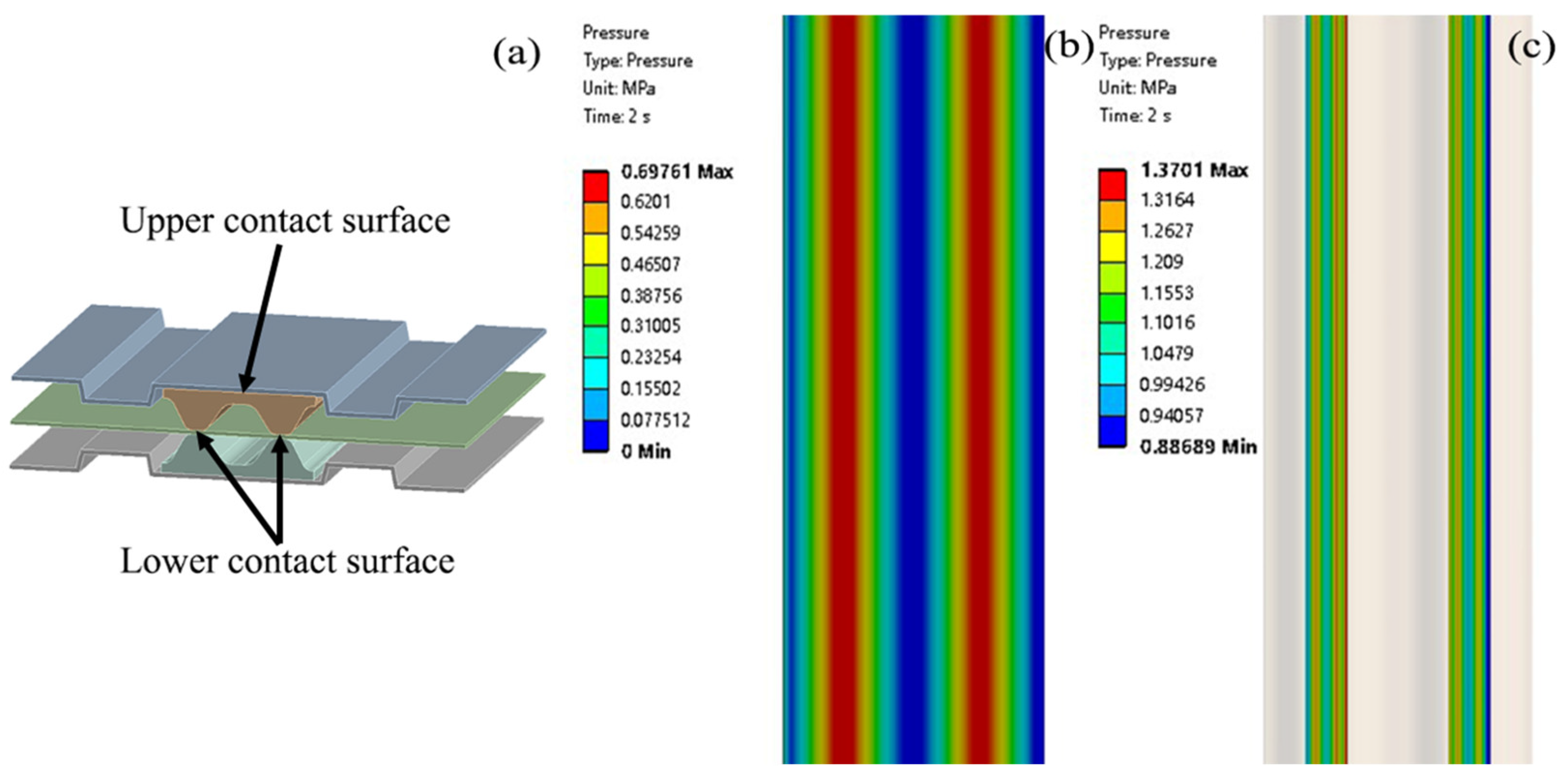
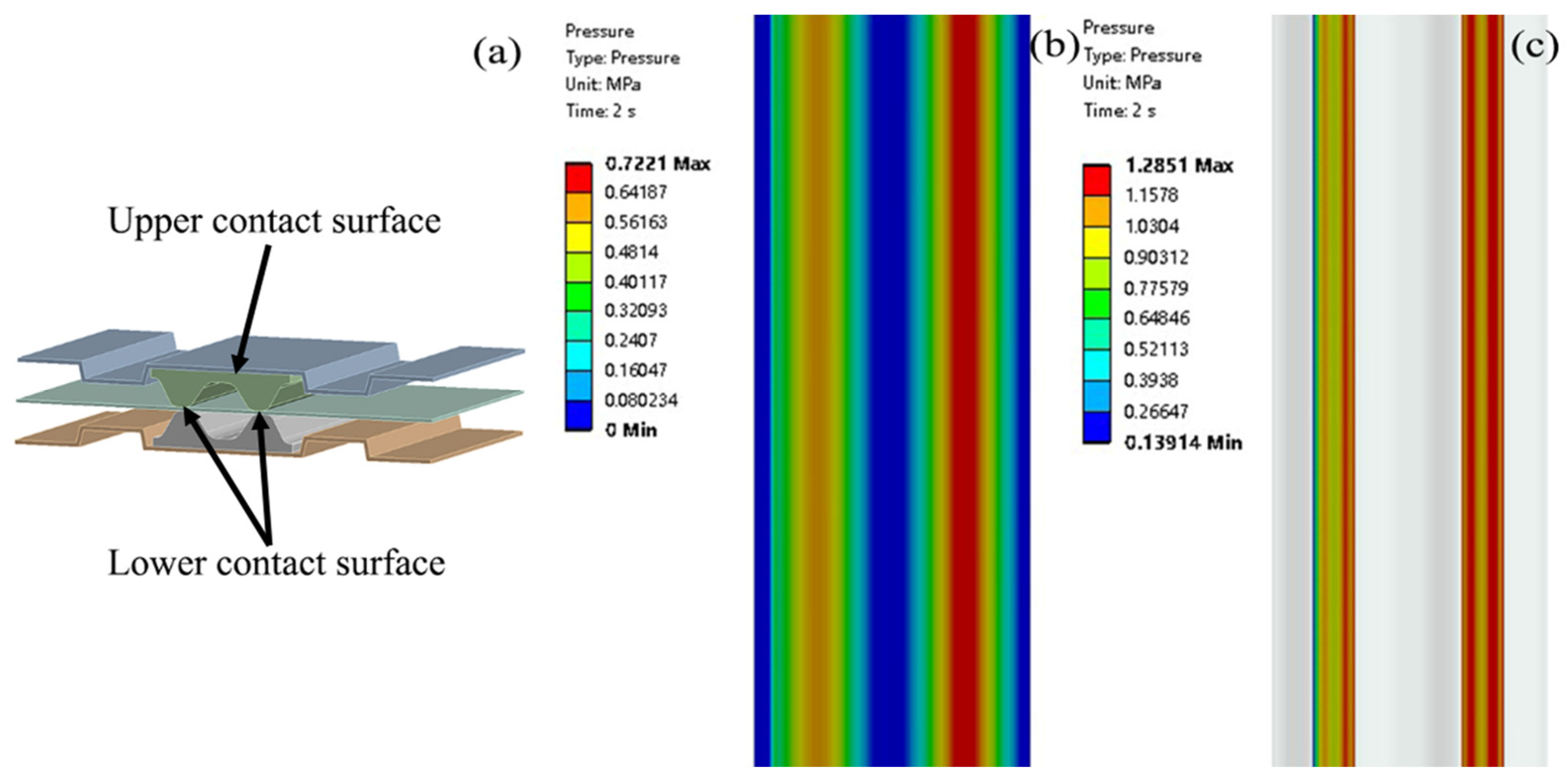


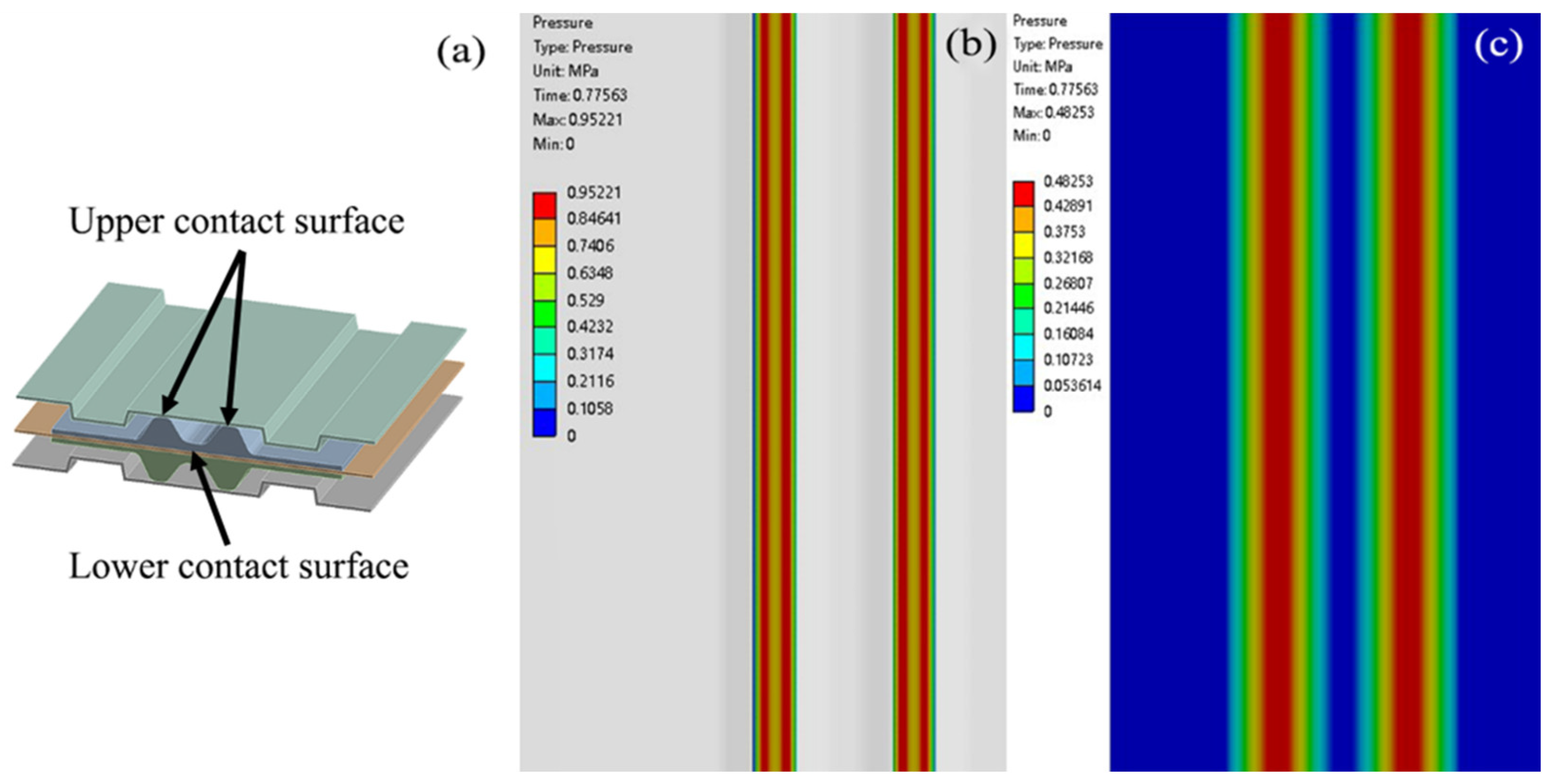


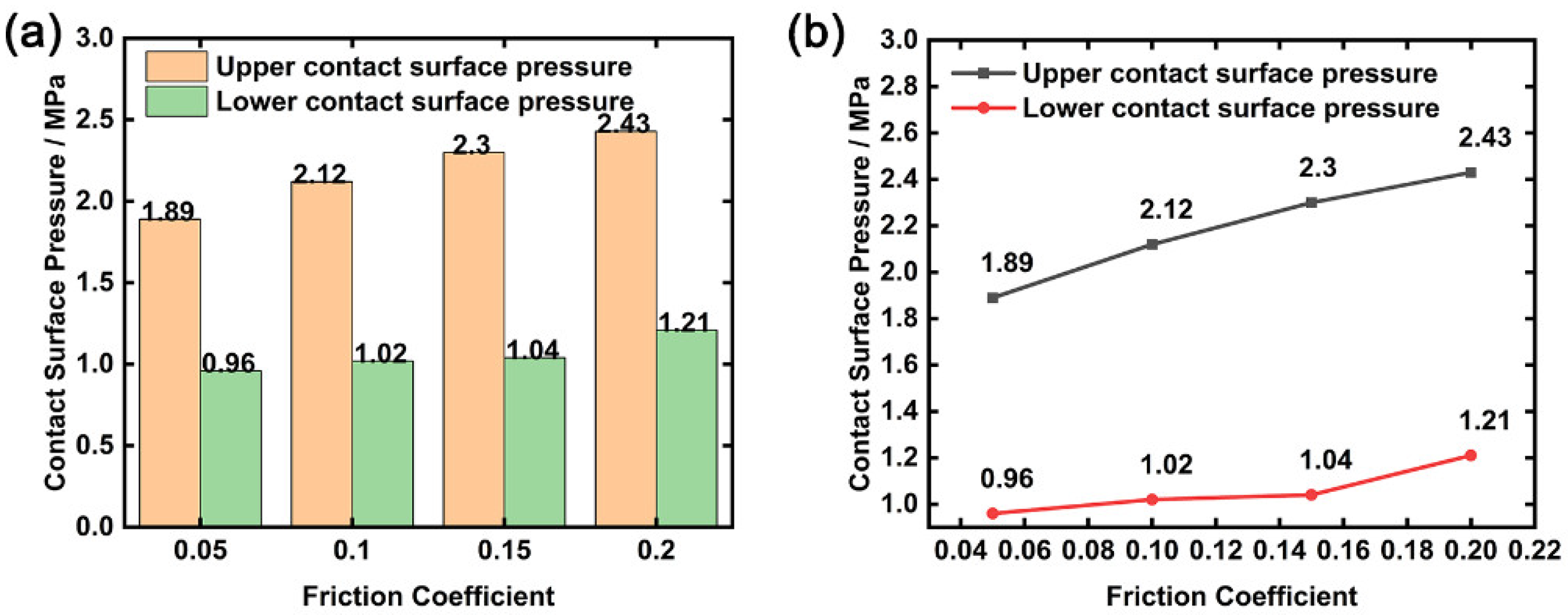
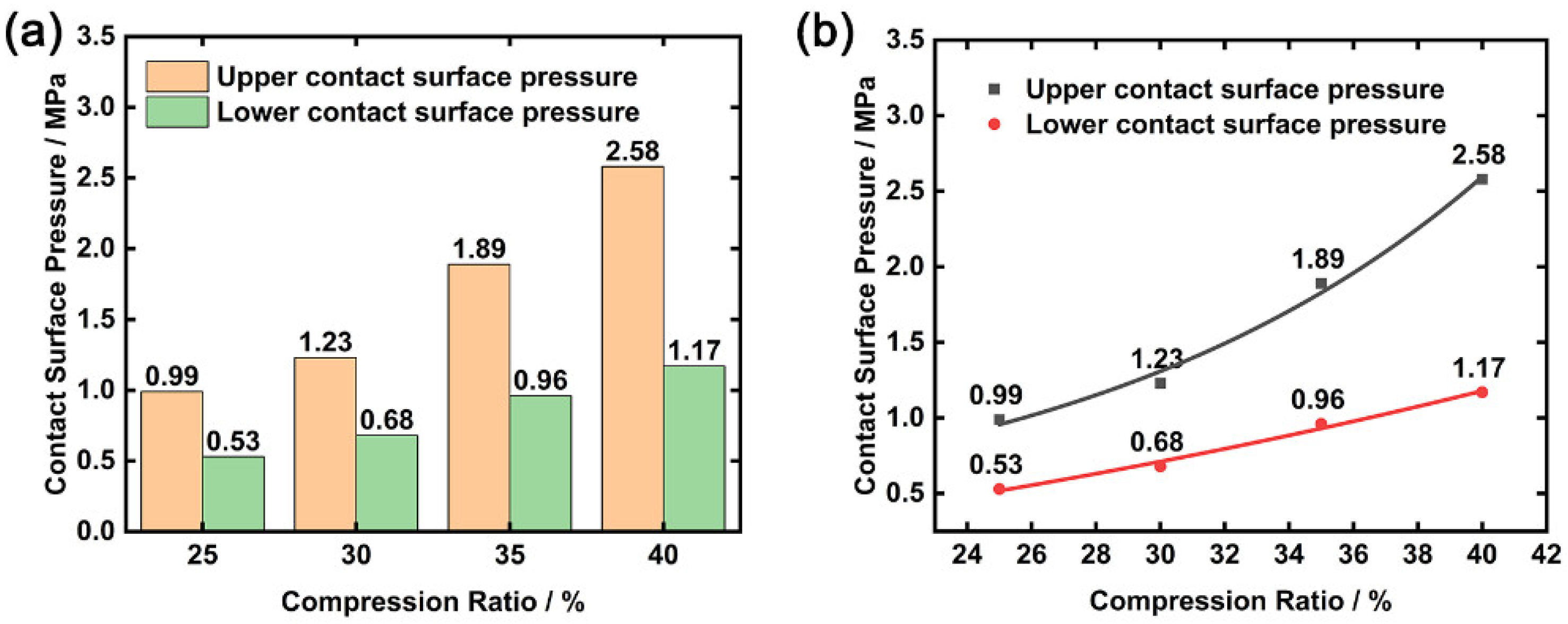
| Component | Young’s Modulus/MPa | Poisson’s Ratio |
|---|---|---|
| Metal bipolar plate | 193,000 | 0.27 |
| MEA frame | 17,640 | 0.3 |
| Hardness (Shore A) | C10/MPa | C01/MPa |
|---|---|---|
| 45 | 0.2341 | 0.0513 |
| 50 | 0.2897 | 0.0599 |
| 55 | 0.3744 | 0.0657 |
| 60 | 0.4947 | 0.0639 |
| Compression Ratio /% | Initial Pressure/kPa | End Pressure/kPa | Pressure Difference/kPa |
|---|---|---|---|
| 25 | 100 | 75 | 25 |
| 30 | 100 | 94 | 6 |
| 35 | 100 | 99 | 1 |
| 40 | 100 | 99 | 1 |
| Compression Ratio /% | /(MPa · mm) | /(MPa · mm) | |
|---|---|---|---|
| Upper Contact Surface | Lower Contact Surface | ||
| 25 | 0.042 | 0.039 | 0.064 |
| 30 | 0.062 | 0.049 | 0.059 |
| 35 | 0.084 | 0.061 | 0.055 |
| 40 | 0.107 | 0.072 | 0.051 |
Disclaimer/Publisher’s Note: The statements, opinions and data contained in all publications are solely those of the individual author(s) and contributor(s) and not of MDPI and/or the editor(s). MDPI and/or the editor(s) disclaim responsibility for any injury to people or property resulting from any ideas, methods, instructions or products referred to in the content. |
© 2023 by the authors. Licensee MDPI, Basel, Switzerland. This article is an open access article distributed under the terms and conditions of the Creative Commons Attribution (CC BY) license (https://creativecommons.org/licenses/by/4.0/).
Share and Cite
Zhao, J.; Guo, H.; Ping, S.; Guo, Z.; Lin, W.; Yang, Y.; Shi, W.; Wang, Z.; Ma, T. Research on Design and Optimization of Large Metal Bipolar Plate Sealing for Proton Exchange Membrane Fuel Cells. Sustainability 2023, 15, 12002. https://doi.org/10.3390/su151512002
Zhao J, Guo H, Ping S, Guo Z, Lin W, Yang Y, Shi W, Wang Z, Ma T. Research on Design and Optimization of Large Metal Bipolar Plate Sealing for Proton Exchange Membrane Fuel Cells. Sustainability. 2023; 15(15):12002. https://doi.org/10.3390/su151512002
Chicago/Turabian StyleZhao, Jinghui, Huijin Guo, Shaobo Ping, Zimeng Guo, Weikang Lin, Yanbo Yang, Wen Shi, Zixi Wang, and Tiancai Ma. 2023. "Research on Design and Optimization of Large Metal Bipolar Plate Sealing for Proton Exchange Membrane Fuel Cells" Sustainability 15, no. 15: 12002. https://doi.org/10.3390/su151512002
APA StyleZhao, J., Guo, H., Ping, S., Guo, Z., Lin, W., Yang, Y., Shi, W., Wang, Z., & Ma, T. (2023). Research on Design and Optimization of Large Metal Bipolar Plate Sealing for Proton Exchange Membrane Fuel Cells. Sustainability, 15(15), 12002. https://doi.org/10.3390/su151512002











